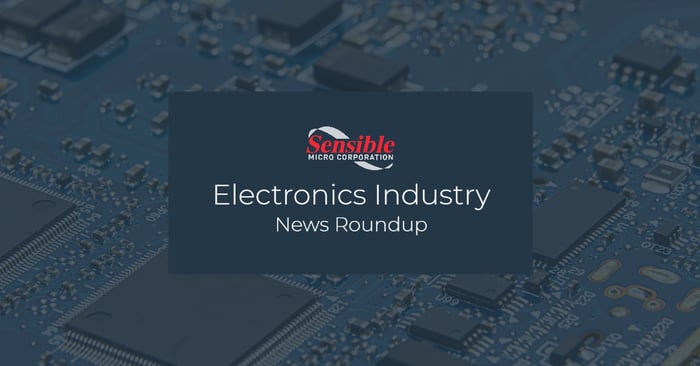Taiwan chip maker TSMC's $12 billion Arizona factory could give the US an edge in manufacturing:
(Source) Taiwan Semiconductor Manufacturing Co. (TSMC), the third-largest chip-making company in the world, announced this month that it will be bringing more manufacturing power in the United States. TSMC plans to build a factory in Arizona, costing roughly $1.2B USD. Construction on this new facility is slated to begin in 2021 and is expected to create more than 1,600 jobs. This is great news for the US government, as our current administration has raised concerns over the semiconductor industry's reliance on manufacturing done in Asia.
Expressed best in a tweet by Secretary of State, Mike Pompeo, “The TSMC deal "bolsters US national security at a time when China is trying to dominate cutting-edge tech and control critical industries.”
TSMC has stated that it "welcomes continued strong partnership" with the US government and that production at this new factory is expected to begin in 2024.
Pandemic Delays Electronic Product Launches:
(Source) It is no secret that the current COVID-19 pandemic has affected the electronics industry. The extent of its impact is major, affecting every part of the supply chain. According to a market survey and study put out by Supplyframe, a vendor of electronic design, manufacturing and supply chain services, approximately 53% of recent electronics product launches have been delayed or canceled due to the pandemic. In addition to product launches, electronic device re-designs have increased due to component shortages. Product designs are having to be “de-risked” earlier on in the design cycle and scrutinized more thoroughly.
As stated by Supplyframe’s CEO and founder, Steve Flagg, “Eighty percent of the lifetime risk and cost of a typical hardware product is decided during that product’s design process, companies need to examine what’s happening in the design phase because that’s where the disconnect often exists.”
The study found that about 91% of electronic manufacturing services (EMS) survey respondents said that delays in their product launches were contributed to sourcing issues. While still in the midst of the pandemic, it is hard to judge what electronic manufacturers will have to do to cope with the COVID fallout in the future but supply chains will most likely need to be reconfigured to meet industrial and consumer demands of a post-pandemic market.
COVID-19 Shifts Voice User Interface from Feature to Necessity:
(Source) Since the beginning of the COVID-19 pandemic, extensive efforts have been made worldwide to slow the spread of the virus and ‘flatten the curve.’ Now, even as economies begin to reopen, many protective measures and hygienic practices are expected to become commonplace. For example, the US Centers for Disease Control and Prevention (CDC) has recommended avoiding touching high-traffic and touch surfaces, especially when in public places. High-touch surfaces include things like elevator buttons, light switches, trash can lids, and door handles. While many of high-touch devices already have voice-user interfaces (VUIs) incorporated in their designs, it is expected that more products will be made with voice-activated technologies in the wake of this pandemic. Zero-contact devices used in public places may become more desirable if not made mandatory. Though VUIs were already gaining popularity prior to COVID-19, it is likely that their momentum will continue to increase and will intersect with the global trend towards personal and public health, safety and security.
NAND Flash Revenue Undergoes 8.3% QoQ Growth in 1Q20:
(Source) Recently reported by DRAMeXchange, the research division of TrendForce, NAND Flash bit shipment in Q1 of this year was on par with Q4 of 2019 and that overall average selling prices (AVP) of NAND Flash memory products increased in this time period. Fortunately and somewhat surprisingly, the traditional Chinese Lunar New Year shutdowns and COVID-19 have not had a notably, negative impact on storage demand and server supply chains. As a result, global NAND Flash revenue in Q1 went up by over 8%, totaling $13.6B USD. It is expected that NAND Flash contract prices and supplier revenues will continue to increase throughout the remainder of Q2 this year.
New Product Releases:
1. Murata - SCC3000 Series Combined Dual-Axis Gyroscope and 3-Axis Accelerometer:
Murata recently launched the 3rd generation of MEMS (Micro-Electro-Mechanical Systems) 4DoF (four-degrees-of-freedom) and 5DoF (five-degrees-of-freedom) inertial sensors. The SCC3000 series is very reliable, high quality, and has stable output over a wide range of temperature, humidity and vibration conditions. Applications for this new series include, but are not limited to, Electronic Stability Control (ESC), dynamic chassis control, and lane-keeping assistance (LKA).
2. Renesas - Introducing Advanced Signal Conditioner IC:
Renesas announced its newest product, ZSSC3240 sensor signal conditioner (SSC). In sensor applications, such as infrared thermometers and resistive pressure sensors, the ZSSC3240 delivers high sensitivity and flexibility. This new product offers superior accuracy for compensated sensor results with up to 24 bits ADC resolution is also available in a bare die format.
3. C&K - Expansion of Soft Feedback Tact Switch Family With Ultra-Low Sound Version:
C&K has improved and bettered its tactile switch offering to now include a long travel, low sound, and positive tactile feedback version. The Tact Low Sound (TLS) Series offers advanced haptic communication with ultra-soft feedback. The TLS series gives engineers the ability to reduce the size of printed circuit boards (PCBs) and can be customized to meet vehicle interior requirements.
4. ROHM - New Automotive Monolithic LED Driver:
ROHM’s new automotive monolithic LED driver, the BD18336NUF-M, has been designed to ensure stable lighting even during battery voltage drops. The BD18336NUF-M is manufactured on a single chip and is ideal for a broad range of socket-type LED lamps used in vehicle systems. Applications include DRLs (Daytime Running Lamps), position, rear, and fog lamps.
Stay on top of the latest developments in the industry by subscribing to the Sensible Micro blog today.


















